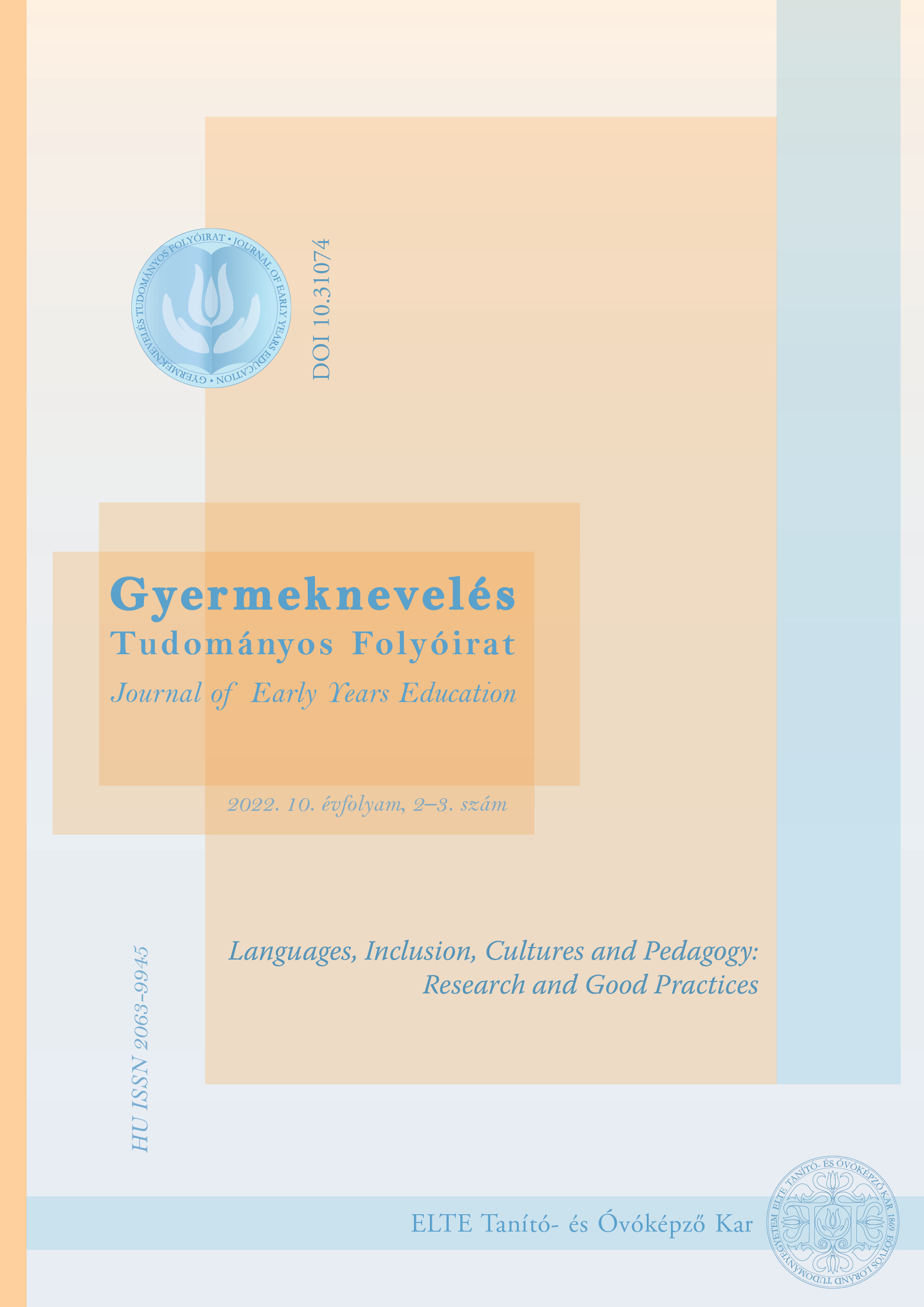Inclusive society – Reality and virtual reality
DOI:
https://doi.org/10.31074/gyntf.2022.3.61.71Kulcsszavak:
inclusive society, virtual reality, disabilities, autism, cerebral palsy, wheelchairAbsztrakt
After clarifying the concept of inclusivity, the chapter lists the factors that need to be borne in mind by a society that treats people with disabilities as equal citizens. Possible means to achieve this goal are properly applied virtual reality methods. The chapter highlights some of the methods that can be applied to people with autism, learning disabilities, cerebral palsy, and wheelchairs, and to help these people with disabilities live as independent life as possible for them. The tools of virtual reality can also play an important role in sensitizing and shaping attitudes in an inclusive society. The third part of the chapter focuses on these possibilities.
Letöltések
Hivatkozások
Alshaer, A., O’Hare, D., Archambault, P., Shirley, M. & Regenbrecht, H. (2020). How to Observe Users’ Movements in Virtual Environments: Viewpoint Control in a Power Wheelchair Simulator. Human Factors, 62(4), 656–670. https://doi.org/10.1177/0018720819853682
Arlati, S., Colombo, V., Ferrigno, G., Sacchetti, R. & Sacco, M. (2020). Virtual reality-based wheelchair simulators: A scoping review. Assistive Technology, 32(6), 294–305. https://doi.org/10.1080/10400435.2018.1553079
Bernardes, M., Barros, F., Simoes, M. & Castelo-Branco, M. (2015). A serious game with virtual reality for travel training with Autism Spectrum Disorder. 2015 International Conference on Virtual Rehabilitation (ICVR), 127–128. https://doi.org/10.1109/ICVR.2015.7358609
Billings, D. M. (2008). Inclusive teaching. The Journal of Continuing Education in Nursing, 39(7), 296–297. https://doi.org/10.3928/00220124-20080701-13
Chowdhury, T. I., Shahnewaz Ferdous, S. M. & Quarles, J. (2019). VR Disability Simulation Reduces Implicit Bias Towards Persons with Disabilities. IEEE transactions on visualization and computer graphics, 27(6), 3079–3090. https://doi.org/10.1109/TVCG.2019.2958332
Dechsling, A., Shic, F., Zhang, D., Marschik, P. B., Esposito, G., Orm, S., Sütterlinl, S., Kalandadze, T., Øienn, R. A. & Nordahl-Hansen, A. (2021). Virtual reality and naturalistic developmental behavioral interventions for children with autism spectrum disorder. Research in Developmental Disabilities, 111, 103885. https://doi.org/10.1016/j.ridd.2021.103885
Dewsbury, B., & Brame, C. J. (2019). Inclusive Teaching. CBE Life Sciences Education, 18(2), . https://doi.org/10.1187/cbe.19-01-0021
El-Shehaly, M., Zeitz, K., Zeitz, R., Logan, K., Tao, C., Kim, J.-S., Gračanin, D., White, S. W. & Richey, J. A. (2013). A VR based intervention tool for autism spectrum disorder. Paper presented at the Proceedings of the 18th International Conference on 3D Web Technology, San Sebastian, Spain. https://doi.org/10.1145/2466533.2466574
Gagliardi, C., Turconi, A. C., Biffi, E., Maghini, C., Marelli, A., Cesareo, A., Diella, E. & Panzeri, D. (2018). Immersive Virtual Reality to Improve Walking Abilities in Cerebral Palsy: A Pilot Study. Annals of Biomedical Engineering, 46(9), 1376-1384. https://doi.org/10.1007/s10439-018-2039-1
Gordon, C., Roopchand-Martin, S. & Gregg, A. (2012). Potential of the Nintendo Wii as a rehabilitation tool for children with cerebral palsy in a developing country: a pilot study. Physiotherapy, 98(3), 238–242. https://doi.org/10.1016/j.physio.2012.05.011
Harrison, A., Derwent, G., Enticknap, A., Rose, F. D., & Attree, E. A. (2002). The role of virtual reality technology in the assessment and training of inexperienced powered wheelchair users. Disability and Rehabilitation, 24(11–12), 599–606. https://doi.org/10.1080/09638280110111360
Headleand, C. J., Day, T., Pop, S. R., Ritsos, P. D. & John, N. W. (2016). A Cost-Effective Virtual Environment for Simulating and Training Powered Wheelchairs Manoeuvres. Studies in Health Technology and Informatics, 220, 134–141. https://www.ncbi.nlm.nih.gov/pubmed/27046566
Kollar, J. (2013). Világunk (h)arcai.Beszélgetések fogyatékossággal élő emberek életéről. TT. Play Kft.
Kollar, J. (2020). Gamification in Education. Changing the Attitude of Medical Students Towards Dementia by Using Virtual Reality (Pilot Study). Pupil: International Journal of Teaching, Education and Learning, 4(2), 57–67. https://doi.org/10.20319/pijtel.2020.42.5767
Manju, T., Padmavathi, S. & Tamilselvi, D. (2018). A Rehabilitation Therapy for Autism Spectrum Disorder Using Virtual Reality. In Venkataramani, G. P., Sankaranarayanan K., Mukherjee, S., Arputharaj, K. & Narayanan, S. S. (Eds.), Smart Secure Systems – IoT and Analytics Perspective (pp. 328-336). Springer Nature. https://doi.org/10.1007/978-981-10-7635-0_26
Newbutt, N., Bradley, R. & Conley, I. (2020). Using Virtual Reality Head-Mounted Displays in Schools with Autistic Children: Views, Experiences, and Future Directions. Cyberpsychology, Behavior, and Social Networking, 23(1), 23–33. https://doi.org/10.1089/cyber.2019.0206
Optale, G., Urgesi, C., Busato, V., Marin, S., Piron, L., Priftis, K., Gamberini, L., Capodieci, S. & Bordin, A. (2010). Controlling memory impairment in elderly adults using virtual reality memory training: a randomized controlled pilot study. Neurorehabilitation and Neural Repair, 24(4), 348–357. https://doi.org/10.1177/1545968309353328
Orm, S., Dechsling, A., Sütterlin, S., Øien, R. & Nordahl-Hansen, A. (2020). Virtual Reality to Enhance Social and Emotional Skills in Children with Autism Spectrum Disorders. Research in Developmental Disabilities, 111, https://doi.org/10.1016/j.ridd.2021.103885
Standen, P., Brown, D., Blake, R. & Proctor, T. (2000). Effective strategies of tutors teaching adults with learning disabilities to use virtual environments. Proceedings of the Third International Conference on Disability, Virtual Reality and Associated Technologies - ICDVRAT2000. Alghero, Italy.
Zhao, J.-Q., Zhang, X.-X., Wang, Ch.-H. & Yang, J. (2020). Effect of cognitive training based on virtual reality on the children with autism spectrum disorder. Current Research in Behavioral Sciences. 2, 100013. https://doi.org/10.1016/j.crbeha.2020.100013.
##submission.additionalFiles##
Megjelent
Hogyan kell idézni
Folyóiratszám
Rovat
License
Copyright (c) 2022 Szerző

This work is licensed under a Creative Commons Attribution-NonCommercial-ShareAlike 4.0 International License.

